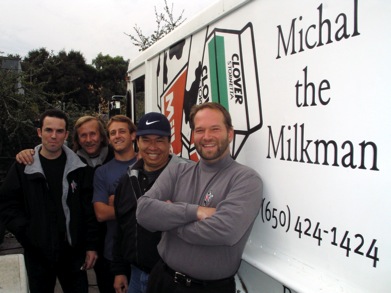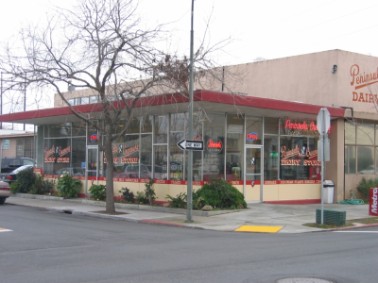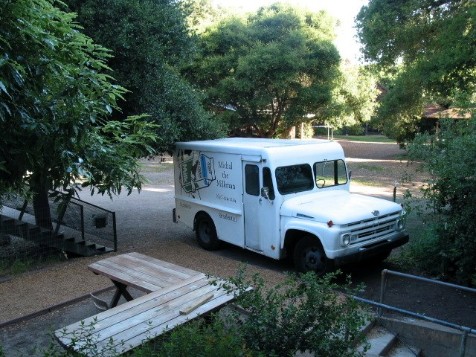Palo Alto Milkmen:A Delivery from the Past:
Note: This story was written in 2008
“Where did the milkman go?” ask Susan Jonas and Marilyn Nissenson in their wonderful 1994 book, Going, Going, Gone. The authors answer that question and nearly eighty others in a collection of articles describing “Vanishing Americana” — artifacts and habits we think of as quintessentially American, but which are no longer with us. Some of the items are fun to remember but certainly have few supporters rallying for their return — rotary phones, girdles, and leisure suits come to mind. And other defunct phenomena such as DDT, fur coats, and the smell of burning leaves say something about the growth of environmental awareness in our society.
But then there are those cherished slices of Americana that still hold a place in the nation’s collective memory. Bike-riding paperboys, doctors who make house calls, and gas station attendants who checked your oil and tires no longer make much business sense. Still, when they faded away, it seemed that some part of the American experience left with them. And what about the milkman? The memory of the driver stepping out of the Divco truck in his crisp white suit to drop off those glass bottles — well, is there anything that seems both so outdated and yet so sadly lost?
After all, these days it is possible to run your daily errands with an almost total lack of social interaction. You can pump self-service gas, shop at the grocery store and choose the self check-out line, bank at the ATM (avoiding the teller fees), and even end up at an automated post office machine — all without ever speaking to a live person. And when you do interact with a salesperson or clerk, it is often a cold, machine-like transaction. Not that you can really blame the person behind the counter. Sure, maybe a trip to family-operated establishments like J J & F’s Market or Bell’s Books will get you a big how-do-you-do and some personal service, but it’s hard to fault the underpaid and often under-respected workers at the big national chain stores if they view you as just one of hundreds of transactions in an eight-hour shift.
In days past, the milkman was perhaps the ultimate illustration of customer service. Originally ,poor refrigeration meant that milk was delivered daily with the aid of horses that knew the routes by heart, stopping at each house while their bosses carried the crates of glass bottles right to the doorstep. Hence the phrase,
"Change the milkman but not the horse." Even in the Great Depression, 70% of milk sold was delivered door-to-door by more than 70,000 milkmen nationwide.
Milkmen were always more than just deliverymen with dairy products. Many kept a house key and put the milk, eggs, and cheese right in the refrigerator — or, in the early days, down in a cellar ice box. They were also known to help in other ways — leaving food out for a dog or cat, reaching something on a high shelf for an elderly customer, changing a fuse for an ill-equipped housewife. And many old-timers still remember the yellowish cream at the top of the bottle that on cold days would expand outside into “high hats." There were also the milk chutes many homes were equipped with to make delivery easier and the endless vaudeville circuit jokes about the milkman’s good fortune at spending the workday visiting lonely housewives.
In Palo Alto, a bevy of local creameries made milkmen valued community members. In fact, the city was a kind of regional dairy capital. In 1906, local Palo Alto milk was sent to San Francisco following the earthquake. A 1930 Palo Alto Times story tells with pride of three Palo Alto dairies that finished “win, place, and show” at the Pacific Slope Dairy Show in Oakland. Indeed, in the first half of the 20th century, creamery plants and soda fountains thrived in Palo Alto. Piers Dairy, the Golden State Creamery, Easton Creamery, Altamont Creamery, University Creamery, and Gold Seal Creamery all did brisk business.
Most successful of all was the Peninsula Creamery, whose milkmen at one point served some 12,000 customers in their red and cream colored trucks. Founded in 1922 by Axel Raven and Howard Cobb, the boys soon established a brand name and slogan (“Made right — right in Palo Alto) and succeeded through ambition, a 3 A.M. daily wake-up time, eight-cent milk pints, and a rented Ford truck. In 1936, the Creamery was bought by John Santana who turned the Peninsula Creamery fountain on Emerson Street into a local institution by selling “Choc Malts,” BLTs, and the thickest shakes in town to travelers and Paly students alike.
Milk delivered from the Peninsula Creamery plant was different from the dairy products available at the newfangled supermarkets. A 1950s' ad told of the “extra freshness” that came from producing milk from the 700 or so cows on the Peninsula Troutmere Guernsey Farm, "thereby assuring fresh pure wholesome
milk.” Originally Creamery cows had roamed the Stanford pastures where the Stanford Shopping Center now stands.
Ice cream was an even bigger seller. From 1957 to 1994, the Peninsula Creamery plant turned out as much as three million gallons a year and more than 200 flavors. The well-known label could also be found in the freezers of Bay Area supermarkets. Still, despite the popularity of such flavors as “Blue Vanilla,” “Dad’s Root Beer Float” and “Sticky Fingers,” the Creamery shut down its milk bottling plant in 1985. The ice cream plant lasted until 1994, when a city directive to switch from an ammonia coolant system to Freon proved too expensive.
Of course, milkmen had met their demise in the Bay Area even earlier. By the 1960s most folks were picking up their dairy products on trips to Safeway or Lucky. And although Creamery milkmen hung around until the 1980s, eventually even they faded away.
And yet there is still one milkman in Palo Alto who keeps the tradition alive. For 21 years, “Michal the Milkman” has been delivering milk, cheese, butter, cream — even Choco Tacos and Astropops. When the Palo Alto native started his business in 1987, with fond memories of Wally, the Peninsula Creamery milkman of his childhood days, Michal had so few deliveries he carried them in a backpack on his Yamaha motorcycle. But word soon spread about this blast from the past and his customer base grew. Today he and his crew of milkmen deliver to nearly 200 loyalists, big and small, in a vintage fleet of trucks from the 1950s and '40s.
Like his milkmen forefathers, Michal is more than just a deliverer of dairy products. Some customers give him their house keys so he can put the milk right in the fridge. And like his predecessors, he has been known to change light bulbs and do other small household chores for older folks. A few years back, one 93-year-old customer fell to the floor and could not get up. He simply waited for Michal to arrive the next day to help him up. Another time, the milkman found a high-schooler in tux and tails whose ride to the prom had fallen through. Soon he was standing on the floorboard of Michal’s milk truck, setting a new standard for arriving at the prom in style. For many
customers, Michal is like one of the family — and as such he is rewarded with thank you notes, cookies, children’s drawings, old milk bottles — even Beanie Babies.
Today Michal is on the internet at Michalthemilkman.com, but his style remains easygoing and personable. In the website’s testimonials section, there is an evaluation from 5-year-old Jimmy, “I like Michal. He’s nice. He got my ball out of the tree.” And isn’t that the legacy of the milkman? A delivery man and a dairy salesman to be sure — but also, a friend who gets your ball out of the tree.
An old Peninsula Creamery truck sits in a back alley (Courtesy Palo Alto Historical Assocation)

Michal the Milkman and his staff.

The Peninsula Dairy Store is still going strong on High Street.

Michal making repairs.
The Peninsula Creamery is under new management but still thrives at Emerson and Hamilton.

Making a delivery.